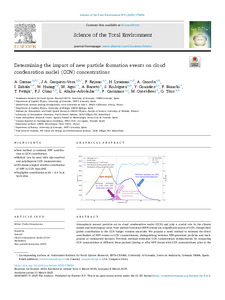Por favor, use este identificador para citar o enlazar este ítem:
http://hdl.handle.net/20.500.11765/16643
Determining the impact of new particle formation events on cloud condensation nuclei (CCN) concentrations
| Título : | Determining the impact of new particle formation events on cloud condensation nuclei (CCN) concentrations |
| Autor : | Casans, Andrea; Casquero Vera, Juan Andrés; Rejano, Fernando; Lyamani, Hassan; Cazorla, Alberto; Zabala, I.; Huang, W.; Agro, M.; Barreto Velasco, África






|
| Palabras clave : | Aerosol; Cloud condensation nuclei (CCN); Nucleation; New particle formation (NPF) |
| Fecha de publicación : | 2025 |
| Editor: | Elsevier |
| Citación : | Science of The Total Environment. 2025, 972, 179094 |
| Versión del editor: | https://doi.org/10.1016/j.scitotenv.2025.179094 |
| Resumen : | Atmospheric aerosol particles act as cloud condensation nuclei (CCN) and play a crucial role in the climate system and hydrological cycle. New particle formation (NPF) events are a significant source of CCN, though their global contribution to the CCN budget remains uncertain. We propose a novel method to estimate the direct contribution of NPF events to CCN concentrations, distinguishing between NPF-generated particles and background or transported aerosols. Previous methods estimated CCN concentration enhancements by comparing CCN concentration at different times periods (during or after NPF events with CCN concentrations prior to the events or with non-event days). Our method overcomes this limitation by focusing on the ceiling size that newly formed particles can reach, the timing of NPF events, and isolating the NPF mode from the overall aerosol size distribution. The method was developed using size-resolved CCN measurements at the Sierra Nevada Station (SNS) in southeastern Spain (2500 m a.s.l.). We demonstrate that the method is also applicable to polydisperse CCN measurements, showing consistency across both variants. Additionally, it has been applied to NPF events at the Izaña Observatory (IZO) in Tenerife (Canary Islands, 2367 m a.s.l.). Both SNS and IZO frequently experience NPF events, though their environmental and aerosol characteristics differ, providing insights into the advantages and limitations of the method. Comparison between the two sites reveals that the mean NPF contribution to CCN is 6.2 ± 4.8 % (IQR = 9 %) at SNS and 24 ± 25 % (IQR = 28 %) at IZO. The higher NPF contribution at IZO is attributed to the ability of newly formed particles to grow to larger sizes and the presence of fewer transported boundary layer particles acting as CCN. Both sites show significant variability in the NPF contribution percentage due to the distinct characteristics of each NPF event. |
| Patrocinador: | This work was partially supported by NUCLEUS project PID2021-128757OB-I00 funded by MICIU/AEI/10.13039/501100011033/ and “European Union NextGenerationEU/PRTR” and BioCloud project RTI2018.101154.A.I00 funded by MCIN/AEI/10.13039/501100011033 and FEDER “ERDF A way of making Europe”. This work received support from the European Union‘s Horizon 2020 research and innovation program through projects ACTRIS.IMP (grant agreement No 871115) and ATMO_ACCESS (grant agreement No 101008004), by the Spanish Ministry of Science and Innovation through projects ELPIS PID2020-120015RB-I00 MCIN/AEI /10.13039/501100011033 and ACTRIS-España RED2022-134824-E and by University of Granada Plan Propio through Singular Laboratory (LS2022-1) program. The work was also partially funded through EU projects FOCI (101056783), FORCeS (821205), CERTAINTY (101137680) and by Research Council of Finland via Atmosphere and Climate Competence Center (ACCC) Flagship (337549,3570902, 359340) and by University of Helsinki, Faculty of Science via ACTRIS-HY. It was also funded by grants BIOD22_001 and BIOD22_002, funded by Consejería de Universidad, Investigación e Innovación and Gobierno de España and Unión Europea – NextGenerationEU. |
| URI : | http://hdl.handle.net/20.500.11765/16643 |
| ISSN : | 0048-9697 1879-1026 |
| Colecciones: | Artículos científicos 2023-2026 |
Ficheros en este ítem:
| Fichero | Descripción | Tamaño | Formato | ||
|---|---|---|---|---|---|
| 1-s2.0-S0048969725007... | 6,41 MB | Adobe PDF |  Visualizar/Abrir |
Los ítems de Arcimis están protegidos por una Licencia Creative Commons, salvo que se indique lo contrario.





